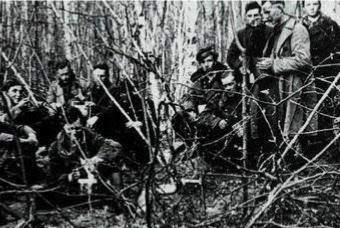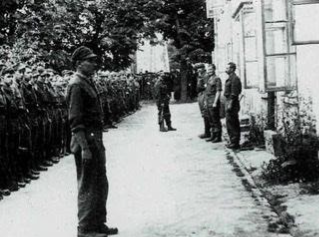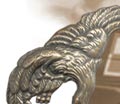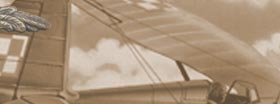Operation JULA and EWA April 1944
Background
From October 1943 Soviet influence on Polish affairs were slowly turning towards the endgame envisaged by Molotov and Stalin for the Sovietization of eastern and central Europe. As the Soviets approached the eastern borders of pre-war Poland, a greater necessity to re-establish diplomatic links between Poland and the Soviets forced President Mikolajczyk to use Eden as a mediator (Bor-Komorowski, 1951). Operation BURZA was in place where the intensive harassing of retreating German rear-guard and diversionary action particularly against rail and road communications would effectively tie down more German army units. Once the Soviet 2nd Belarusian Front crossed the Polish border, BURZA (Tempest) began which culminated in the ill-fated Rising' 44.
The Soviets were using disinformation to destabilise the First Allies relationship with the British and US leaders through claims of low levels of action and the insistence the AK should be incorporated into either the Soviet Army or Berling's First Polish People's Army (Pierwsza Armia Wojska Polskiego) knowing this would be rejected (Bor-Komorowski, 1951). These claims would reappear at the Teheran Conference with additional accusations of the AK harassing Soviet backed partisan units with orders from General Sosnkowski forbidding action against the German Army to sow seeds of doubt since there were no Allied observers in the field to refute or confirm these claims. The level of disinformation from the Soviets was still a key strategy by Molotov well into January 1944 to develop distrust amongst the Allies. Such was the Soviet success in destabilising relationships that General Sosnkowski and Premier Mikolajczyk had conflicting opinions where the General clearly understood resisting Soviet intensions and maintain independence to save and maintain Polish interests otherwise all the war efforts by the AK and the forces in exile would be lost. Premier Mikolajczyk sought a compromise that reflected an approach more in line with the British Government's views. It was clear to the military both within Poland and London that Poland would become a satellite Soviet Republic. Bor-Komorowski released orders on 20th November 1943 for the whole AK to prepare for BURZA operations independently of Soviet or Berling's First Polish People's Army.
General Sosnkowski and Bor-Komorowski's fears were realised when a dispatch from Volhynia on 7th November 1943 indicated a meeting between Bomba a leading AK commander who led over 600 men in the field and General Neumann leading Soviet partisan units, resulted in the Polish commander reported missing and never found (Bor-Komorowski, 1951). This was not an isolated case. With the release of the proposals for post-war Europe and the Curzon Line, the Poles felt increasingly isolated.
In the Spring of 1944 operations around the eastern front continued with fierce fighting around Kovel and Wlodzimierz in Volhynia where the AK 27th Division harried the German rear and with cooperation with Soviet units in other sectors enabled the capture of Turzysk. While there was an element of success, the cooperation threw up a diplomatic issue that needed a resolution that was largely settled through Bor-Komorowski's intervention. As a result, Lt. Colonel Kiwerski (Oliwa) Commander of the 27th Division cooperated in executing tactical tasks with the 56th Soviet Cavalry Regiment until 9th April 1944. The German Army successfully threw back Soviet advances that found the 27th Infantry Division and the 56th Soviet Cavalry Regiment encircled on the Turia River with a breakout and retreat into the Pripyat Marshes (Bor-Komorowski, 1951). The Soviet backed partisans and N.K.V.D began conscripting all males between the ages of 17-35 years old in the occupied areas and pressurising AK units into Berling's army by executing local AK commanders and blocking communications between AK units (Bor-Komorowski, 1951; Walker, 2008; Williamson, 2012) and London.

|

|
|
Units of the 27th Division hiding in the Pripyat marshes
|
'Joining' First Polish People's Army.
|
The German Army had mastered the scheduling and logistics in rail communications that is often overlooked when analysing the Second World War. A key feature in the planning of operation OVERLORD with the invasion of Europe necessitated the need for a comprehensive demolition of rail communications by both bombing and subversive activity. The Poles were still suffering from Soviet disinformation well into 1944 based on lack or ineffective action on rear-guard retreating German units and interference with local AK units that clearly impacted on the 'goodwill' previously shown by the First Ally. To counter Soviet propaganda and to demonstrate the potential strength of the AK, operation JULA was put into action.
Operation JULA
On 12th March 1944 General Sosnkowski ordered (No.2020) an action to disrupt communications and meet increasing political pressure from the Allies and to counter Soviet interference in Poland's internal operations through the demonstration of good will and the effectiveness of the AK (Bor-Komorowski, 1951) while also assisting Soviet advances on the ground. Sosnkowski suggested the operational area should be Rzeszow-Sanok- Przemysl -Sambor and three days later commenced once permission had been granted on the 6-9th April. They cut German rail communication on lines running east-west from Krakow through Przemysl, Bielsko to Lwow and Lodz to Lwow (Williamson, 2012). The detail indicates the level of skill and preparedness the AK had achieved with limited resources and armed men:
- A rail bridge spanning the river Wisloka on the Przeworsk-Rozwadow sector halting rail traffic for 48 hours.
- At Rogozno a steel conduit was blown with a passing munitions train with the tracks mined and derailing rescue trains. The line was blocked with only one track working after 34 hours of repairs.
- Near Nowosielce a steel conduit was blown with a passing munitions train on the Jaslo-Sanok line causing 33 hours of stoppage with only three wounded casualties during a skirmish at the bridge (Bor-Komorowski, 1951 p.190; Walker, 2008; Williamson, 2012).
Lord Selborne, Minister of Economic Warfare wrote a congratulatory letter on 3rd May 1944 congratulating General Sosnkowski and the AK indicating his admiration for them with an underlying message imploring the Poles to continue to cooperate with the Soviets along the front and partisan groups. The letter did not acknowledge the Soviet insistence the AK should be incorporated into either the Soviet Army or Berling's First Polish People's Army (Pierwsza Armia Wojska Polskiego) nor the assassination of unit commanders.
Operation EWA
Ewa was similar to operation Jula in the sense they were 'political' as well as strategic (Williamson, 2012). Ewa was planned to cut all main lines running north-west to south-east from Lodz, Warsaw (Warszawa) and Lwow. Sosnkowski also ordered the interruption of all rail communications around Warsaw, Silesia, Pomerania and on the Bialystok junction (Williamson, 2012). Ewa never materialised due to two reasons: the operation was down graded after 6th June (Operation OVERLORD) and the Soviet advances on the river Bug that was crossed on 20th July 1944 (Williamson, 2012).
Both Operation's Jula and Ewa were designed to be relatively minor actions and does not reflect what was happening on the ground. In one six-month period the AK had:
- wrecked 1,268 railway engines
- damaged 3,318 trucks
- derailed 25 trains
- cut 148 signals
- carried out several assassinations of gestapo officers in districts spread around Poland (Williamson, 2012)
The AK was the largest secret army in Europe that never met its potential due to Soviet interference, misinformation and at times internal bickering within the Government in Exile and its leadership of the political and military wings (Ciechanowski, 1974). Bor-Komorowski's premature orders had not met the conditions Premier Mikolajczyk considered necessary to stabilize support for the Poles (Nowak, 1982; Davies, 2003; Kochanski, 2012) and lacked clarity in terms of an uprising or a military action. The collapse of the Rising'44 can also be laid at the feet of the British where the interdepartmental friction between the Foreign Office and SOE clouded effective decisions leaving the Poles exposed (Davies, 2003) and this was reflected in the daring missions by 1586 Polish Special Duty Flight, use of the No.334 Special Operations Wing and USAAF Operation FRANTIC from Brindisi and Apulia, Italy. The 'malevolent' pro-Soviet element in the role of Philby was not necessarily instrumental in Foreign Office declining Polish needs even at the eleventh hour since SOE had already abandoned them (Davies, 2003) and the Soviet intension towards an independent Poland seemed to be overlooked (Ciechanowski, 1974).
Bor-Komorowski learned of the conclusion of the Yalta Agreement while prisoner in Colditz after the collapse of the Rising'44. The Soviets had demonstrated a truly independent Poland would not exist. Proof came from Soviet callousness during the Rising' 44 watching from across the Vistula as Germany brutally supressed the insurrection. In Bor-Komorowski's own words: "But it was entirely incomprehensible to us why the Allies were giving up to slavery and partition their most faithful and oldest ally of the war" (Bor-Komorowski, 1951 p.385).
Suggested Further Reading
Bor-Komorowski, T. (1951) The Secret Army, 3rd Edn. Victor Gollancz, UK.
Ciechanowski, J.M. (1974) "The Warsaw Rising of 1944", Cambridge University Press, UK.
Davies, N. (2003) "Rising' 44: The Battle for Warsaw", Macmillan, UK.
Kochanski, H. (2012) "The Eagle Unbowed: Poland and the Poles in the Second World War", Allen Lane, UK.
Nowak, J. (1982) "Courier from Warsaw", Wayne State University Press, USA.
Walker, J. (2008) "Poland Alone: Britain, SOE and the Collapse of the Polish Resistance, 1944", The History Press, UK.
Williamson, D.G. (2012) "The Polish Underground: Campaign Chronicles", Pen and Sword Military, UK
Top of Page
|





